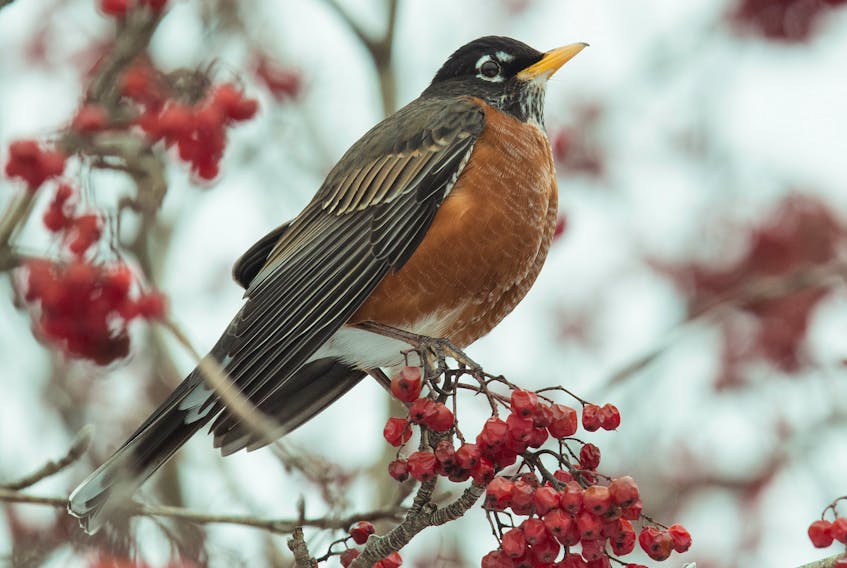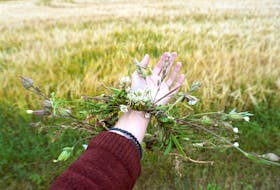This has been an easy winter in eastern Newfoundland. Snow fall amounts have been below normal and temperatures have been above average. The dogberry crop has nothing to do with the mild winter depending on which folklore theory you follow. However, the combination of a mild winter and a big crop of dogberries has meant a winter of luxury for the American robin.
Robins are totally hooked on the dogberry. So much so that they can be enticed to linger well into a Newfoundland winter by feasting on the berries. It is a gamble. They are thinking of the present and not so much about what they will do if the berries run out before spring. In the past there have been hard times for robins that stayed too long and did run out of food in mid-winter. This year everything worked out to perfection. The soft winter weather and the endless supply of dogberries was a gambling robin’s dream.
The benefit of overwintering in Newfoundland versus going somewhere warmer in the south is the migration effort saved. Migrating a thousand kilometers or more to a southern destination in the fall and then retracing the steps back to Newfoundland again in spring is a risky business. Travelling on your own steam, using built-in senses for navigating across the land and some sea is full of potential perils. The robins that stayed here this winter are one big step ahead of the game. They look good and are acting strong and vigorous. Meanwhile, the majority of Newfoundland robins did migrate south in the fall. When they arrive back in the province in beginning in early April they will be surprised to find hundreds of robins already here ahead of them!
With spring fever growing stronger every day (robins) are practising singing. Coming across one of these noisy flocks of robins is like coming into a shower of spring. You are instantly transported a month forward.
The robins were spread out thinly across the province during the winter. It seems they have conglomerated into large flocks and pushed east. Since early March they have descended on the Avalon Peninsula like a spring blizzard. Everyone is noticing them whether you are an avid bird watcher or a casual back yard birdwatcher. And the Avalon Peninsula has the berries to keep them going right into spring. The bright orange plump berries of December have degenerated into a shrivelled red shell. But within that plastic-like skin of the berry is a concentrated pulp. I sampled a few. If anything, they taste a little bit sweeter than the bitter fall berries. Maybe they have fermented a little providing extra octane for the robins.
Being a social bird in winter robins work best in flocks. They move into an area and gorge on berries all day long. They gobble a few down then sit back in a tree to let them digest. It is like living in a grocery store. You can only eat for so much of the day. In their spare time they socialize with mock chases and much vocalization. With spring fever growing stronger every day they are practising singing. Coming across one of these noisy flocks of robins is like coming into a shower of spring. You are instantly transported a month forward.
Other species of birds cannot help but be caught up in the enthusiasm of the moment. Hairy woodpeckers might be drawn out of the woods and start pecking on the birches among the dogberry trees looking for dormant insect morsels. Chickadees appear doing chickadee things within the dogberry trees. There are increasing reports of cedar waxwings on the Avalon Peninsula but so far, the bohemian waxwings are restricting their activities to central Newfoundland. Purple finches often join in with the robins to dine on the berries. They also do not mind letting forth with a few practice songs of their own. The robins create a welcome atmosphere that the local birds cannot resist.
Genuine signs of spring
We will hardly notice the arrival of the first spring migrant robins from the south, but other spring arrivals and signs of spring will be more obvious. The first ring-billed gulls will arrive around the 20th March. Both crows and ravens have been seen breaking sticks off trees to build new nests or fix up last year’s nest. The Signal Hill bald eagles have been touching up the old nest. Black-legged kittiwakes are starting to migrate north along the coast and the first local Avalon Peninsula breeders are at looking at cliff-side nest sites. Great cormorants have been decked out in spring attire for a few weeks now sporting white flank patches and white frosting around the face. Herring gulls at Quidi Vidi Lake are getting louder as they find a renewed interest in each other. The juncos are singing louder every day.
Winter is waning. We are on the edge of spring.
Bruce Mactavish is an environmental consultant and avid birdwatcher. He can be reached at [email protected]









